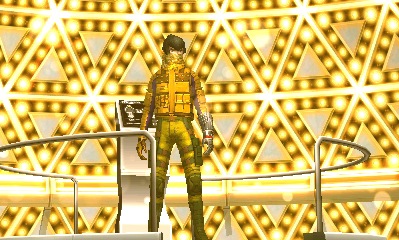It's not every day that you see a game like Shin Megami Tensei IV, especially on the 3DS. It hints at a mysterious tale early on, befitting the series' reputation for brooding themes and hellish settings, and this dark wash informs the attitude and appearance of the world, which is unsurprisingly experiencing an influx of demonic activity. You play as a samurai charged with protecting the Kingdom of Mikado, and the invading demons are yours to recruit as much as to destroy, keeping with the series' well-known catch-'em-all mindset. But make no mistake: although demon hunting, recruiting, and fusing may provide some of the best experiences here, there's more to enjoy beyond the demon-hunting trappings.
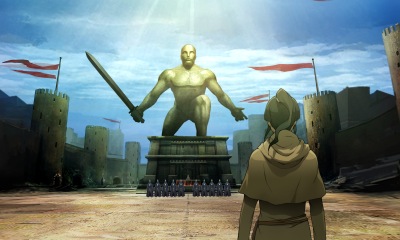
After the game's vague and mysterious opening cinematic, you wake at Lake Mikado, where a friend, who's eager to get the both of you to the Gauntlet Rite ceremony, gets the main story rolling. The coming-of-age ritual for Mikado teens involves a test where applicants engage with futuristic-looking gauntlets, and the rare few who elicit a reaction from their gauntlet are initiated into the samurai ranks. It's here that you learn the intricacies of the dual-class Mikado populace, divided into the privileged Luxurors and the humble Casualries.
Shin Megami Tensei IV is steeped in the notions of affinity and contrast, and they're carefully woven into the story of your intimate group of samurai prentices. The supporting cast members all have strong personalities, though unfortunately, they never grow beyond their roles. Shin Megami Tensei IV harps on differences of opinion, forcing you to side with one or another to progress the story in a particular way. In that regard, the samurai serve their function quite well. However, unlike in a series such as Persona--an offshoot of Shin Megami Tensei--where relationships are nurtured and characters evolve, the characters here are borderline perfunctory.
Your first taste of samurai duty takes place in the Naraku caverns: Mikado’s link to the demon world that has long served as a training ground for budding samurai. Your gang of four heads into Naraku, but you travel alone due to the competitive nature of the exercise. It's here that your gauntlet's AI personality, Burroughs, comes to life and introduces you to the world of demons.
Instead of fighting alongside your samurai comrades, you recruit and command a flock of demons. These fiends must be coaxed into your fold; there's no Pokeball-like mechanic here. The hundreds of demons in the game come with personalities all their own, and negotiating the Press Turn negotiation system can prove to be a challenge early on. Some demons continuously request goods or currency, only to flee once they've had their fill. Others join you out of fear of their own demise. A few tricks of the trade exist, such as giving in to some requests but ignoring the third or fourth, but there are times when monsters introduce battles of wit, where you must judge their sensitivity to beauty or aggression, for example. A demon's appearance can tip you off in some instances, but it's rarely a straightforward process.
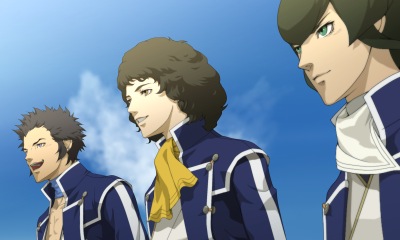
One of your first training missions requires you to fill out your battle roster, and the initial challenge of negotiating the Press Turn system provides your first clue to Shin Megami Tensei IV’s unrelenting difficulty. When you fail to entice demons into a partnership, they might flee, but it's more common for them to fight back.
When you aren't actively recruiting demons, the first-person battles become turn-based exchanges of physical and magical attacks. Elemental affinity is important, and a poor decision in battle, be it an incorrect spellcast or the breakdown of a negotiation, can reset the flow of battle in the opposition's favor, and your upcoming turns are wiped clean. This can spell doom for an unprepared party, and if you aren't lucky, it's a lesson learned very early on, but the game doesn't necessarily end with a single premature death.
Instead of facing a game-over screen, you awake in a hellish landscape, lined with tortured souls, by the river Styx. A ghastly ferryman, who's apparently too busy to worry about your meager spirit, offers to resurrect you for a fee rather than add to his existing burden. Interestingly, this can be handled by either in-game currency--macca--or Nintendo 3DS Play Coins. Play Coins are rarely incorporated into non-StreetPass games, and it's a welcome alternative when you're in a financial pinch.
On your second trip to Styx, which is almost a given, the game's "easy" difficulty is subsequently unlocked. While you might feel ashamed to revert to such an option in other games, Shin Megami Tensei IV is punishing enough on its standard difficulty that you should realistically consider toning down the challenge, if only to progress further into the game. There are many strict rules to consider during battle, and staying alive can feel like an uphill battle early on, but it becomes easier with practice.
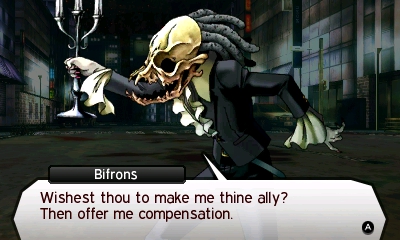
Once you've managed to build a team of demons, you soon learn that they can be fused together. Standard fusions require two specific demon types, but there are also special fusions, which call upon a third ingredient. Fusions come with trade-offs: the new demon may not have the same statistics or elemental resistances as either of the two going in, and it's natural to feel apprehensive about risking a prized partner. To promote the growth of your roster through fusion, you can register demons and resummon them for a fee later on, ensuring they're never lost for good. It's rare that you feel a strategic need to combine your cohorts, but it's a good way to combine disparate skills from two demons into a single combatant.
The designs of the various demons are the most interesting aspect of Shin Megami Tensei IV's presentation. The demons range in appearance from grotesque mounds of flesh to odd conglomerations of real-world animals, and apart from a handful of deviations in their illustrative style, all are rendered exceptionally well. The presentation shares a lot with Shin Megami Tensei: Strange Journey, but that was a Nintendo DS game. It's disappointing that the visuals haven't improved much across generations, apart from the vastly improved dungeon exploration. Demons sometimes shift in place when performing a move, or you might see a flash of color accompany certain actions, but they're generally stiff. In fact, the myriad death animations are more impressive than anything you see when demons are actually fighting.
Outside of battle, things get a little better. You navigate a simple 3D world from a third-person perspective, with your character's chosen equipment in plain sight, which is a nice touch. The majority of environments are unfortunately flat, with little in the way of contrasting colors or interesting lighting. Enemies emerge from the ground, represented as digital-looking figures constructed from blue cubes. It's possible to outrun them in the field, but when you want to engage in combat, you're encouraged to tap the X button to attack a nearby foe. Doing so ensures that you gain the first turn in battle, where failing to hit your target often results in the opposite outcome.
If you decide to play on the easy difficulty, the most recognizable difference comes during combat. Enemies aren't necessarily less powerful or smart, but you gain the monumental ability to flee from standard enemies, guaranteed. The hardest moments in the game are when you're thrust into a battle unprepared, and thus are killed before you can react appropriately. While the standard challenge is fair, there's something positive to be said for a system that eases the challenge without dumbing down the game at large.
Eventually, you find yourself on a world map. Unsurprisingly, it consists of more drab coloring, so much so that paths become difficult to distinguish. It's presented from a distant top-down view, and you're seen as little more than an icon against the brown and dark-gray landscape. Enemies are present, too, but are much harder to avoid given how cramped and unclear the pathways can be. That might be tolerable on its own, but there are bigger problems at hand than tight spaces. When you're instructed to visit a particular location, it can take quite a bit of wandering to find your way. Key locations are pinpointed on the map, but you can't identify their names unless you're already in the vicinity.
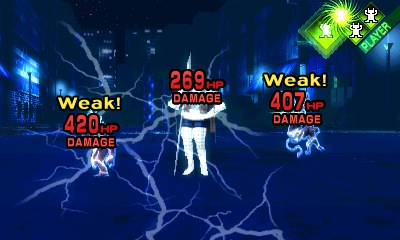
With the powerful gauntlet on your wrist, and the helpful AI Burroughs instructing you in the ways of the samurai and demons, you would expect to be able to track the names as well as the locations of the places you've been. Because this is not the case, the overworld map leaves a lot to be desired in terms of functionality. When you cross multiple bridges that require time-wasting discussions with toll collectors, it's downright frustrating to find yourself in the wrong location. A series of terminals does exist that can teleport you to some locations, but they're little help when you're headed somewhere without one.
Thankfully, Burroughs is useful in other ways, acting as the conduit to your equipment, demon management, and the ever-helpful save-anywhere function, for example. Crucially, she's your lifeline to quests, both obligatory and optional. Various hunter guilds across the game's world offer challenges, as do demons, on occasion. Burroughs tracks and stores these quests, which range from item collection to special battles against powerful demons. On the occasion that you find yourself underleveled, challenge quests provide an easy way to beef up your stats and macca count. You won't need to spend too much time dabbling in them in order to complete the game, but they extend your time considerably without feeling like cheap diversions. Demon hunting is fun in itself, but it's good to see there's more to explore here.
Throughout your quest, you face key decisions that ultimately influence the story. Quite often, these come in the form of siding with one friend or another. You're primarily a silent character, but the agency granted to you by the power of choice saves you from feeling like a mere passenger heading toward a conclusion. The ripples you make throughout your tale grow larger as the story comes to a close, which is good. But, knowing how long you need to play in order to impact the story makes repeat playthroughs via the New Game Plus feature seem like a chore in the making. However, if demon collecting is your thing, you may be enticed to extend your time as a samurai. Just know: your entire roster gets reset. You maintain your current level and abilities, if you choose, but you'll need to recollect demons. Thankfully, you earn considerably more experience points from challenges and quests, making it easy to level up demons quickly, and chase those ever-elusive "special" fusions.
With its raw, horror-inspired settings, Shin Megami Tensei IV fits right in with other games in the series, yet in many ways it's unlike anything else in the current 3DS library. It's occasionally weak, held back by menial character development and a frustrating overworld, but it provides a challenging combat system made even more interesting through discussions and arguments with fantastically designed demons. Unfortunately, it's not a pillar of character development, or the best-looking game of its type. It's saved by the lure of the dark and mysterious world and the trials of fighting its inhabitants make Shin Megami Tensei IV a great role-playing game worth seeing through to the end. The excellent combat and the almost never-ending quest to explore the compendium of demons should keep you coming back for more, even if you have a fairly good assumption of what the other endings might entail.
